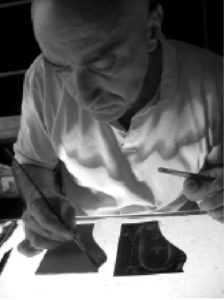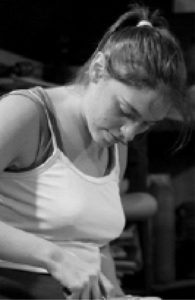Pablo learned to make stained glass the Renaissance way: from generation to generation. As a child, he used to steal glazier’s putty from his parents’ atelier to play and painted with tempera colors every piece of glass he could find. At the age of 10, he already cut glass and at 13, he made his first stained glass at National University of Cuyo’s request.
After attending Architecture School at Mendoza’s University, he was entirely consecrated as a stained glass artist. Compelling evidence of it, is the First International Prize 1994, award he received for his work restoring the stained glass windows at the National Government House (Pink House).
Pablo masters the art of glass, making alternative use of his knowledge of Classical and Contemporary techniques, as each work requires it. His profound cognition of the chemical treatment of oxides, acids and pigments, applied to glass modeling and other materials, has enveloped in alchemy his work, which continues its expansion in our country.
Pablo has know how to combine his wide experience in Restoration of artistic works -many of them decorate some of the most emblematic buildings in Argentina- with the realization of original pieces of art, stained glass sculptures and murals.
Nowadays, as Atelier’s director, he dedicates his time to stained glass restoration and consultancy in historic heritage restoration, as he works on his next art exhibition.


Lucía began her training as a stained glass artist, very young as well, when she was only 13, at Pablo Subirats’ atelier. Under his guidance, and in line with how the knowledge is transferred in this family atelier, Lucía was trusted with its centenarian wisdom. She is fully trained in realization, restoration and value enhancement of stained glass.
Nowadays, Lucía combines her work at the atelier with her own entrepreneurship in object design.
Martín began his artistic education at the atelier during his adolescence. Due to his natural skills and talent in drawing, he is currently working as Templates and Drawing Project Assistant.
Alejandro has become a valuable assistant in General Artistic Tasks. He is specialized in lead smelting and milling.
Ramón was born in Barcelona, in the neighborhood of Gracia. At the age of 12, he started working at the Printer’s “Seix y Barrial” and painting in a theatre in Barcelona. After a few years, he joined the School of Arts and Crafts of Barcelona, where he stood out for his talent as an illustrator and was awarded with a Mention in 1908 and a Silver Medal in 1911. He took night classes at the Artistic Circle of Sant Lluc in Barcelona.
That same year he moved to Argentina. After a hard first year in Buenos Aires, he decided to settle in Mendoza, where he painted commercial posters and ads to make a living. In his spare time, he went with his oil pastels to the fields to portrait the farmers.
In 1915, he made his first consignment to the “1st Pastelists Hall” in Buenos Aires. At the opening, he met his future wife, the painter Graciana María Ursomarzo, disciple of Eduardo Sívori and Alberto Rossi at the National Academy of Fine Arts. They had three sons: Roger, Fivaller and Wifredo. The three of them accused the artistic genetics of their parents, but is Fivaller the one who would professionally devote himself to arts and continue with the family atelier.
He lived in Buenos Aires until 1924, where he held several exhibitions, including one in 1920, composed mainly of charcoal drawn portraits, for the National Commission of Fine Arts. Later on, he went to the province of San Juan, where he conducted the decoration of the House of Spain. There, he became a close friend and lived together with the renowned painter and engraver, Lino Enea Spilimbergo.
During the following years, his artistic activity was permanent. Due to his extensive knowledge and experience in drawing and modeling in sepia and charcoals, his modeling with oxides and pigments on glass was superlative. So they called him to carry out all the decoration of the Good Shepherd Chapel of Mendoza, where the stained glass panels and stained glass windows stand out; the building of La Mercantil Andina and the Legislature of Mendoza, to mention some of his most significant works at that time.
He participated in art events, travelled and exhibited in Mendoza, San Juan, Valparaíso, Santiago de Chile, Rosario, Buenos Aires, Montevideo, Paraná and Entre Ríos. He collaborated in the opening of the Aboriginal Park in Mendoza with his designs, and participated in the organization and inaugural exhibition of the Academy of Fine Arts of the province.
In 1938, he began in Buenos Aires his tour through Northern Argentina, Paraguay, Brazil, Bolivia, Peru, Ecuador and Colombia, aiming to document the aboriginal traits of South America. In order to achieve that, he requested and was granted the National Government’s sponsorship and support from “La Crítica”, a popular newspaper from Buenos Aires.
Numerous are the charcoal and pastel paintings that he made during his journey through Cuzco and Lima. The Ministry of Justice and Direction of Prisons of Lima gave him official permission, as a special correspondent of the Argentinean government, to conduct plastic-racial studies at the Women’s Prison of San Miguel.
In 1941, already in Quito, the Ecuadorian government granted him a free rail pass to facilitate his work. In 1942, he crossed to Colombia, where he worked very hard on an exhibition, that was supposed to open on February, 7th. That same day, Ramón suddenly died.
Fivaller, Ramón’s second son, followed his footsteps. Also since childhood, stained glass marked him: a scar on his left hand, the result of playing with glasses of the family atelier, was clear proof of that during his whole life.
He was trained by the Chilean sculptor Lorenzo Domínguez and the engravers Víctor Dehlez and Sergio Sergi. Also, he studied at the School of Visual Arts at the National University of Cuyo, where he met –the then also Visual Arts student- María Antonia Russo, who he married in 1949. They had three children: Mónica, Claudia y Fivaller Pablo.
Fivaller was professor of Fine Arts at various Secondary Schools and the National University of Cuyo. He combined his teaching vocation with a plural artistic career. He excelled in oil painting of murals, frescos and stuccos. He conceived sculptures in stone, metal, cement and wood. His engravings were mostly made out of wood and metal.
In 1958, with the birth of his youngest son, Pablo, Fivaller addressed himself almost exclusively to stained glass. He dedicated many years of his life to study the behavior and technology of materials and the application of Classical and Contemporary techniques to stained glass. His work (handmade stained glass, stained glass windows and doors, stained glass lamps, stained glass panels, stained glass patterns consistent with the rest of the decoration) can be found in Mendoza, San Juan and Salta.